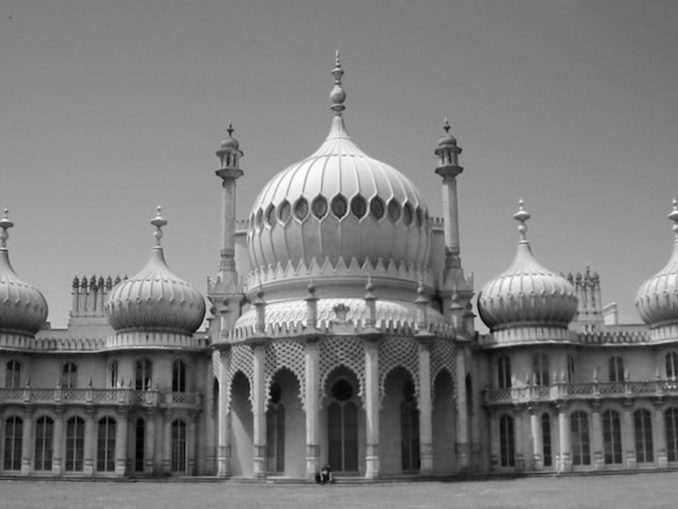In 1954, the Manchester Evening News launched a “Special Investigation” and tasked my uncle, John Alldridge, with answering the question –
Holidaymakers, do you get value for your MONEY?
What follows is his report on Brighton. It gives a good idea of what holidays were like 65 years ago. Jerry F
Brighton: A cocktail blend of sea and air and fun
From Hastings to Bournemouth the whole South Coast is really one vast elongated holiday camp; over a hundred miles of it.
And all of them – St. Leonards, Bexhill, Eastbourne, Worthing, Littlehampton, Bognor – as like as highly polished peas.
One day some social historian with a sense of humour will write a book explaining the extraordinary similarity of English seaside architecture. No doubt he will reason out why, for instance, every self-respecting pier pavilion must look as much as possible like the Taj Mahal; why sober English boarding-houses have such ornate, almost raffish exteriors.
I suppose, if you care to go back far enough you can pin the blame on a certain Dr Richard Russell, who hung up his plate opposite what is now the Palace Pier here at Brighton almost exactly 200 years ago.
It is fascinating to think that had it not been for Dr Russell it is very likely that there would have been no Tower at Blackpool; while Brighton might still have been a pleasant little fishing village instead of a thriving metropolis with a rateable value of almost £2M.
It was Russell – the original “Dr Brighton” – who conceived the idea of salt-water baths. Publication of his book on the “curative properties seawater” brought the famous and the fashionable flocking to his house.
But even Dr Russell could not have brought it off without the help of the Prince Regent. If the doctor set the example it was the Prince who set the fashion.

The Royal Pavilion in Brighton, England,
Xgkkp – Licence CC BY-SA 3.0
Because the Prince liked to spend his weekends at Brighton, a holiday by the sea became a British institution.
In 1937 about 15M of the 46M in Great Britain took a period of holiday by the sea or in the country. By 1941 – a peak year for the holiday resort industry – the number had risen to over 20M, of whom it was believed 15.2M went to the sea and 5.6M to the country. In addition, 2.7M took holidays in inland towns (the vast majority went to London), and only 1.3M went abroad.
Of the remainder, 5M took daily trips as their only form of holiday – and nearly 15M stayed at home.
It is quite possible that in a few more years the total number of holidaymakers on the coast or in the country may reach the 30M mark.
Far from welcoming this possibility those whose livelihood depends on catering for the holiday trade – and in Brighton alone this accounts for 52.5 per cent of all women “gainfully employed” – view it with alarm.
For unfortunately the average Englishman takes himself and his family on holiday in the four weeks around the August Bank Holiday (two holidaymakers out of every five use that period). And so inevitably all resorts and all forms of transport to the seaside must be crammed in late July and August.
And 60 per cent of all complaints from disgruntled holidaymakers stem from uncomfortable lodgings and crowded trains.
On the transport side Brighton, only 50 miles from London, is better served than most resorts. Three trains an hour from London Bridge and Victoria can – and do – lift 1½M people between June and August in comparative comfort.
To house this annual migration Brighton has 205 hotels and 2,000 recognised lodging and apartment houses in the centre of the town. At a pinch it can bed down 200,000 at one time.
It could take care of half that number in comfort – but only if holidays were evenly spread over at least four months of the year.
But as recently as 1951 there was no indication that staggered holidays had even begun. If anything the position was worse than ever: 63.5 per cent of all main holidays that year were taken in July and August. A higher percentage even than in the peak year, 1949.
Since the war we have been spending between us around £340M on our fortnight’s holiday. What do we expect in return? In order of priority, I suppose:
- Good weather – which means sunshine and warmth.
- Reasonable accommodation – which means a good bed and ample well-cooked food at a sensible charge.
- Fair prices all round.
- A reasonable variety of entertainment.
Weather
On the score of weather, Brighton usually has little to worry about. One of its best-selling slogans is “As Sunny as Its Name!” It boasts, with accuracy, 1,700 sunshine hours a year – which is about 800 more than Manchester.
And on one of those fine mornings of hard, glittering sunlight that superb Regency promenade can hold its own with Nice or Monte Carlo.
But this summer Brighton, as everywhere else, has suffered its worst weather in a quarter of a century. Boatmen report only 18 days’ business so far. The figures for sea bathing – which Dr Russell introduced and on which the early fame of the town rested – are already 20 per cent down on last year.
And so far too many depressed holidaymakers have been faced with that ancient question: “What do we do if it’s wet?”
Writing to the “Brighton and Hove Gazette” last week one disappointed family man complained:
“We found there was only one suitable place, the Aquarium, but after two visits that began to pall. All that was left were the cinemas, theatres, and the ice rink, which we have at home and did not particularly want to visit, anyway.”
A ticklish problem, this, for the seaside towns, already facing stiff opposition from the holiday camps which can guarantee an “all-in” weather-proof holiday.
Often antiquated local bye-laws do not help. Here breezy Brighton is more enlightened than most. More than fifty local restrictions – one forbade rowing-boats to come within ten yards of female bathers – have been abolished since 1938.
But there is still much to be done. In Dieppe, just across the water, the cafes are open all day. Brighton must make the most of its extra half-hour “holiday extension”.
And it is still – officially – a crime to undress on the beach.
Accommodation
Suitable places to stay in Brighton vary as elsewhere. Until the British Health Resorts Association can agree to follow the Continental example and insist on a common standard of catering, cleanliness and general amenities for its hotels and boarding-houses it must be so.
On this tour, I am taking pot-luck: knocking at the first window with a “Vacancies” card in it (and, believe me, there are plenty!) and accepting what follows without question.
Here at Brighton, I have been lucky. On that most regal King’s Road I booked in at one of those
“Regency houses, row on row,
In crescent, square and street.
With pediment, square and portico
‘Bed and breakfast’ all complete”.
In this case “b-and-b” was 17s, rather more than the Brighton average, but worth the extra half-crown for that bow-window view of the highly polished sea. They promised me a good breakfast, and it has been all that and more.
My room, though tiny – this was a doll’s house built for some gay little lady from Drury Lane without doubt – is spotlessly clean. Soap and towel – still rarities – are provided. Morning tea arrives to the minute.
And – nice touch! – I am allowed my own front-door key. Significantly, perhaps, of the other nine guests, five are from the North.
Prices
Nor have I seen any outward signs of overcharging in Brighton. Perhaps two medium-sized strawberries on a cream-splashed biscuit is dear at a shilling. But people who indulge in these outlandish luxuries deserve all they get.
Is fourpence a lot for a pier-toll? Perhaps not. And certainly it is nice to sit down to a high tea of “fresh-caught Brighton fillets” (with chips 3s. 6d) and they are (a) fresh caught and (b) plural.
Not everybody has been so lucky, of course. A Hove housewife complains to the local paper:
“Our dearest restaurants charge three times as much as it costs a housewife to serve a well-cooked meal. Our cheapest charge appears to be three shillings for a pancake with some dried herbs and described as ‘savoury omelette’. Between these two extremes all joints are served warmed after slicing”.
Entertainment
A reasonable variety of entertainment? Well, Brighton has two piers, five theatres, fourteen cinemas, and an ice-rink. The theatres seat 5,000 and – if the Hippodrome is any standard to go by – are as attractive outside as in.
They specialise in “family entertainment” which – as far as I can judge – is strictly for the family. The bigger cinemas are showing films London hasn’t yet seen at less than West End prices.
It has that fantastic Arabian Nightmare, the Pavilion, looking very clean and spruce just now and showing off a priceless collection of royal tableware.
And there is, as the town guide tells you, Seven Miles of Seafront Delight, much enhanced by day by a superb show of flowers and shrubs (the parks superintendent, of course, is a Lancashire man), and at night by the most tasteful display of illuminations – Blackpool take note – I’ve seen.
One thing I missed: a good military band. Not that I’m particularly partial to brass bands. But somehow a Guards band playing “Pinafore” belongs somewhere in this Brighton seascape.
Summing up
Not everybody’s cup of tea? No, perhaps not.
And Brighton, whose advertising – despite a natural buoyant enthusiasm – is still a model of restraint, wouldn’t claim that at it is. What it does offer you is a cocktail blend of sea and air and fun.
Credits:
Text:
The British Newspaper Archive (www.britishnewspaperarchive.co.uk)
The British Library Board
© Reach PLC
© Jerry F 2021



